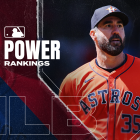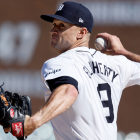As we get set to head into September, we know the pennant races ramp up, as well as discussion over which players should win individual awards. When it comes to MVP, there's this "value" discussion hanging over our heads.
Some people simply believe that the best players are the most valuable. Others attach playing for a winning team as having value. But how do you measure a player's impact on wins and losses? Performing well is one way. Some people will anecdotally bring up "clutch" hits, but it doesn't have to be just a feel thing. We can use win probability added (WPA).
For those unaware, WPA is a useful stat to see how much a player has moved the needle for his team on the season. At any given moment in the game, there's a win expectancy for each team. Based upon historic trends, there's a certain percent chance each team will win during every single hitter of the game.
For example, let's use the biggest WPA swing of the season to illustrate. The Cubs were trailing 3-0 with two outs in the ninth inning to the Nationals on Aug. 12. The Nationals had a 90 percent chance of winning, per win expectancy and without even thinking about the stats involved, that's pretty reasonable, right? And then David Bote happened:
The Cubs went from a 10 percent chance of winning to 100 percent. The 90 percent swing means Bote earned 0.9 Win Probability Added. Most plays are much, much smaller, of course, but that's a quick crash course on why WPA can help measure a player's value to his team on the season. Keep in mind, there can be negatives, too, such as striking out with the bases loaded. Had Bote made an out in our example, he would have been dinged 0.1 WPA, for taking his team's chances from 10 percent to zero percent.
Now, WPA isn't the be-all, end-all stat. No stat is that. WPA only measures the impact of hitters, baserunners and pitchers, too, so we're left without knowing anything about defense.
Let's look at the WPA of some MVP candidates in each league. Again, bear in mind this is hitting only, so someone like, say, Matt Chapman or Francisco Lindor isn't getting full credit for his all-around game. This is but one stat, though it's a really fun one.
AL MVP candidates, ranked by WPA:
- J.D. Martinez, Red Sox, 5.7
- Mookie Betts, Red Sox, 5.1
- Alex Bregman, Astros, 5.0
- Jose Ramirez, Indians, 3.7
- Mike Trout, Angels, 3.4
- Francisco Lindor, Indians, 2.7
- Matt Chapman, A's, 1.8
Again, note Lindor helps in many more ways and Chapman plays unreal defense at third base.
NL MVP candidates, ranked by WPA:
- Aaron Nola, Phillies, 5.0
- Jacob deGrom, Mets, 4.9
- Max Scherzer, Nationals, 4.9
- Paul Goldschmidt, Diamondbacks, 4.3
- Christian Yelich, Brewers, 4.0
- Matt Carpenter, Cardinals, 3.9
- Nolan Arenado, Rockies, 3.4
- Lorenzo Cain, Brewers, 2.9
- Freddie Freeman, Braves, 2.8
- Javier Baez, Cubs, 2.7
Just for fun, Bote is at 1.8 and he's only logged 143 plate appearances. Along with the walk-off slam, he's got a walk-off solo homer and a two-run, game-tying homer in the ninth on his resume.
WPA doesn't only include "clutch" moments, because a first-inning multi-run home run would increase the team's win probability by a decent margin, but it very much measures a hitter's impact on his team's chances of winning a game. Also, WPA isn't a predictive stat. It does, however, tell us how we got here.
Everyone listed here has been excellent for his team throughout the season, obviously, and WPA illustrates how they've swung their team's chances of winning games.






















